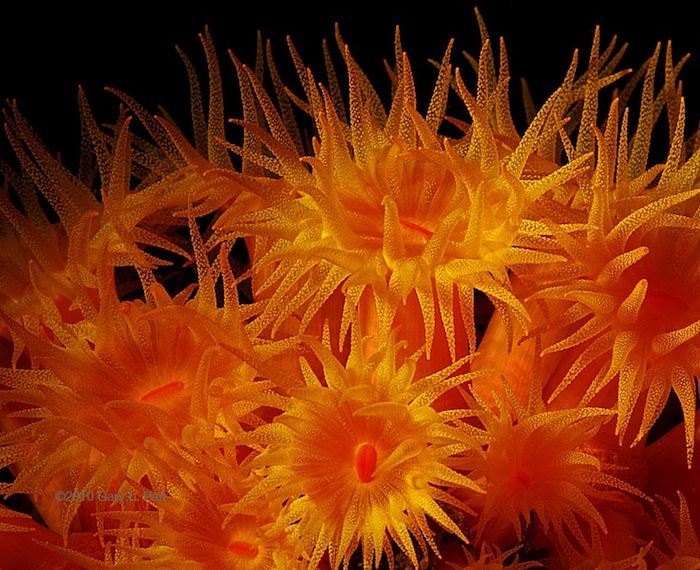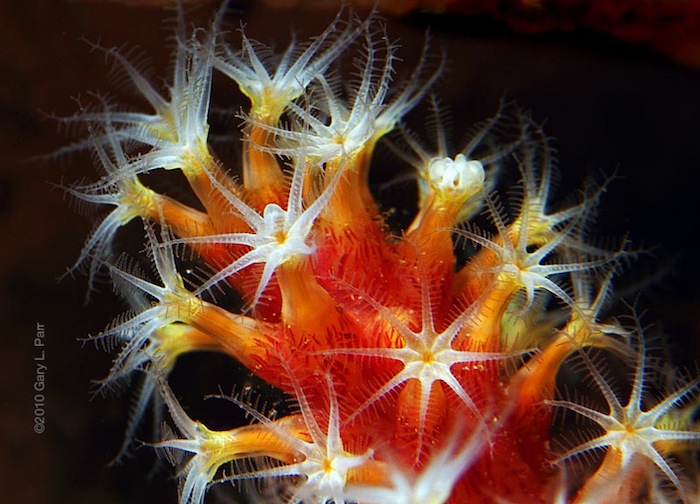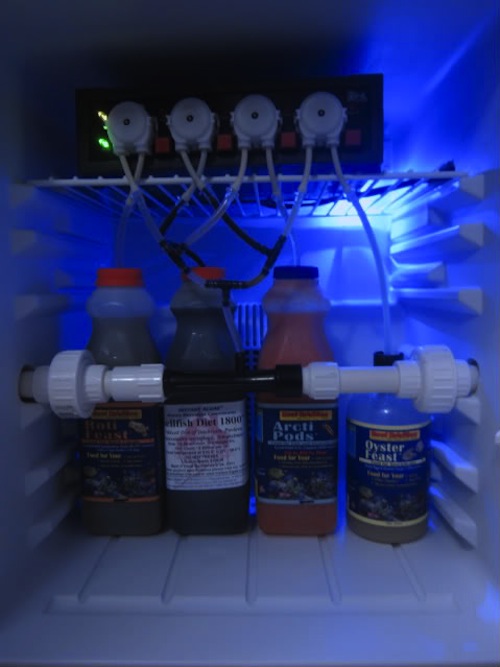By Michael Lukaczyn
As the hobby continues to evolve there is an emerging trend that you will start observe with increasing frequency–aquarist attraction azooxanthellate corals (azoox). Some have said that azoox corals are, or very well could be, the next “SPS” in the hobby and the next frontier in reef keeping. Manufacturers have been using their images to sell their products, companies are creating specific foods and product lines marketed directly toward their care, online communities have generated specific sub-forums on their sites, and recently an azoox specific community has been created. It doesn’t stop there, as online livestock vendors over the last few months have been adding sections to their sites for the sale of non-photosynthetic corals. Clearly, the market has recognized the trend and demand.
Why azooxanthellate corals? Could it be the attraction of not having to pay your local energy provider a second mortgage each month just to keep those beautiful hermatypic scleractinian corals? That alone could pull an aquarist to the dark side. It could simply be the allure of wanting to step outside the norm in a land of “SPS” & “LPS” dominated aquariums. Either way, azooxanthellate corals are not technically impossible to keep, but will challenge your reef keeping ability, as well as your time and patience.
Azooxanthellate corals
First and foremost we need to understand what we are dealing with; corals that do not harbor symbiotic algae are known as azooxanthellate and are ahermatypic (non-reef building). Therefore, they rely on sources of plankton, detritus, and dissolved organic and inorganic matter for their survival. Having knowledge of what they need is only one part of the formula for success; frequency of feeding and the method of how it is administered make the formula even more complex. On the food side of the non-photosynthetic world, two companies have stood at the forefront of providing non-photosynthetic aquarists with what they need–Reef Nutrition & Fauna Marin. Both consistently collaborate with the hobbyists to develop and refine foods/additives to support the nutritional needs of azooxanthellate corals and filter feeders.
Dosing foods by hand, turkey baster or syringe have been traditional methods in feeding azooxanthellates and these methods continue to serve their purpose, but doing so four or more times a day, seven days a week, three hundred sixty five days a year can turn into a daunting endeavor. Automating the majority of your feeding regime can assist in reducing this task. Dry feeds can be measured out and added to a round-o-matic or barrel type feeder over a floating feeding ring, and can be set by the user to broadcast feed the aquarium at their desired interval. Dosing of refrigerated foods is necessary and more complicated. In order to keep the foods consistently refrigerated and to prevent the feeds from fouling in the peristaltic lines, dosing pumps and bottled foods have to be located inside the refrigeration unit. Volumes of foods dosed and intervals of feeding can all be set up through an aquarium controller or a stand alone computerized dosing pump set-up. Even with the best automation, you will still need to get your hands wet with spot feeding corals to ensure individual species needs are met. It is important to document what you are feeding and what you put into the tank. You can easily set up a simple note book, log it into a spreadsheet, or even your daily calendar. Since keeping Azoox corals is largely an experimental affair, having documentation to reference back to is a tool that is vital in keeping track of what has worked or hasn’t worked with particular animals and the system as a whole.
Keeping water quality at optimal levels in a non-photosynthetic system can be challenging due to the constant feeding of the system and nitrate and phosphate control can soon become a husbandry nightmare. Azooxanthellate corals can tolerate mildly elevated levels of waste, but the other inhabitants in your system may not, so attention to pristine water quality is the same as in any reef -keeping endeavor. A well thought out plan has to be developed, evaluated frequently, and adjusted as needed to keep water quality managed. Water clarity is most simply aided by the use of activated carbon. It is an excellent, cost effective method to reduce the yellowing compounds in the water. While using carbon, insure that it is cleaned well to reduce fine particles of carbon that can be released into the water column. Often overlooked due to its complexity and initial set up costs, is the use of ozone. Its ability to improve water clarity and skimmer efficiency makes it an excellent tool to have at your disposal.
Owning an azoox aquarium you will learn to love doing water changes. Doing large water changes two or more times weekly is extremely helpful in managing your system and something I strongly recommend. When removing large volumes of water from your aquarium; it should be done slowly and close to already in tank parameters (temperature, ph, Alkalinity, Calcium, etc). Changing out large volumes without checking parameters of both tank and fresh mixed water is not a good reefkeeping practice.
For phosphate control, honestly, the best method in my opinion is to use Granular Ferric Oxide (GFO) in a reactor. With GFO, phosphates are extremely manageable. Keep in mind that with heavy feeding you will need to monitor PO4 more often than you might be used to since GFO can become exhausted quickly in this type of environment. Lanthanum chloride has also been used successfully as a cost effective measure to win the battle against phosphates. It has become a staple to control phosphates at Atlantis Marine World in Riverhead and select aquarists have also ventured into this realm as well, but please read up well on how to use the product safely and properly. Overdoses of Lanthanum Cloride can quickly eliminate all your livestock in a short period of time, so use caution.
Dosing of Probitics is another method of keeping your nutrients at bay. Whether it is the use of the Fauna Marin Ultralith System, ZEO, Prodibio, or VSV (Vodka, Sugar, Vinegar), these systems have all shown to have their advantages in controlling nutrients in the aquarium and creating a bacteria food source for filter feeders. The introduction of solid carbon dosing via bio-pellets pellets on the market can assist those who don’t want the manual obligation of dosing any of the above systems. Over the short short term, they have shown excellent results in reducing nitrates, bacterioplankton generation, and minimal reduction of phosphates. This method of using PHA polymer based biodegradable plastics for nutrient control is still young in the hobby and is one of those areas where skeptical reef keeping should still apply.

Fine example of a beatifully maintained azoox aquarium with the use of ozone, automated feeding and water changes by Mike Cao.
With time, patience, good planning and husbandry practices in hand, azooxanthellate corals are possible to keep in the home aquaria. Looking toward the next installment, I would like to discuss basic stocking and selection of azooxanthellate corals plus integrating them into them to a photosynthetic aquarium.
References
Brahmi, A.C., Meibom, D.C., Smith, J., Stolarski, S., Auzoux-Bordenave, J., Nouet, D., Doumenc, C., Djediat, I., Domart-Coulon 2010. Skeletal growth, ultrastructure and composition of the azooxanthellate scleractinian coral Balanophyllia regia Coral Reefs 29:175-189
Fabricius, Katharina E. 1995. Flow-dependent herbivory and growth in zooxanthellae-free soft corals. Limnol. Oceanogr. 40: 1290-1301
Fabricius, K.E., Benayahu, Y., Genin, A. 1995. Herbivory in Asymbiotic Soft Corals. Science. 268: 90-91
Richter, C., Wunsch, M. 1999. Cavity-dwelling suspension feeders in coral reefs-new link in reef trophodynamics. Mar Ecol Prog Ser 188: 105-116
Tsounis G., Rossi S., Laudien J., Bramanti L., Fernandez N., Gili J-M., Arntz W. 2005. Diet and seasonal prey capture rates in the Mediterranean red coral (Corallium rubrum L.). Mar. Biol.,
Widdig, A., Schlichter, D., 2001. Phytoplankton: a significant trophic source for soft corals? Helgol Mar Res 55:198-211






0 Comments